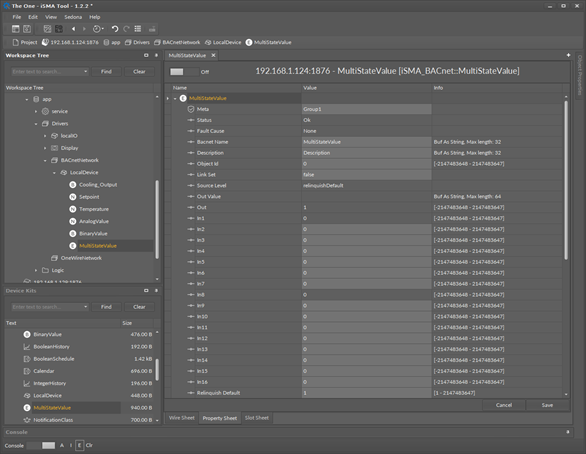The MultiStateValue component is used to share the integer or multistate values data (integer with labels) of iSMA-B-AAC20 controller as the Multistate BACnet objects. The labels assigned to the values can be imported to the BACnet MultiStateValue component from the iSMA_platAAC20 NVMultiStateWritable component.
This component can send data to the BACnet device (when the component inputs in the application are used along with the master device read-only Out slot) or receive data from the BACnet IP master device (when the application uses only Out slot).
WARNING! The MultiStateValue objects use only integer values. which start from 1. Assigning labels to values the user cannot leave empty labels. For example, if the user leaves an empty label in Enum Val7 slot, the BACnet MultiStateValue object will read only the labels from Enum Val1 to Enum Val 6. The labels from slot Enum Val8 and above will be disregarded.
WARNING! In Niagara the labels are read while the database is being added to the system, and after that any label change will be disregarded. To update labels it is required to recall action Discover and use Match option between data points in Discovered and Niagara database.
This component allows to read data from the controller (out slot) or write data (input slots from 1 to 16) to the controller within the BACnet Network. The component has 16 prioritized inputs slots and one output slot. Output slot takes value from the input with the highest priority different from the null value. For example, if only In16, In13 and In9 have values different from null, the output slot will take value from In9, because it has the highest priority from all inputs with value.
Note: In order to avoid receiving the Fault Cause upon adding the point to the network, please follow the below steps:
-
Create the outgoing link from the Out slot of the NVMultiStateWritable (iSMA_platAAC20) component to the In16slot of the MultiStateValue (iSMA_BACnet).
-
Then, in the MultiStateValue component, change the Link Set value to true.
-
In the NVMultiStateWritable component, enter the value in the Enum Val1-16 slots.

MultiStateValue
Slots
The MultiStateValue component has the following slots:
-
Status: component’s current status;
-
Fault Cause: fault cause description;
-
BACnet Name: object name read by the remote device;
-
Description: additional BACnet description of the data point;
-
Units: BACnet data point facets;
-
Object ID: BACnet data point object identification number;
-
Link Set: enable\disable Link Back Forward mechanism (see the BACnet object integration chapter;
-
Source Level: current read input name;
-
Out: MultiStateValue component Out;
-
In1: (read-only) the component input slot with the highest priority, can be set by the Emergency Set action or by the BACnet protocol;
-
In8: (read-only) the component input slot with medium priority, can be set by the Override action or by the BACnet protocol;
-
In2 – In16: writable components inputs (In16 can be set by the Set action);
-
Relinquish Default: object default value, the lowest priority.
Note: The slots below are used for alarm events configuration. To switch the alarm event off, set “None” value in the slot Event Enable.
-
Event State: data point object current alarm event state (read only);
-
Notification Class: notification class BACnet ID Number (max. 10 class objects);
-
Alarm Value 1 - Alarm Value 16: slots defining up to 16 Off Normal data point stages;
-
Event Enable: defines which alarm events will be sent;Available options: To Off normal, To Fault, To Normal, To Off normal and Normal, To Fault and Normal, To Off normal Fault and Normal (recommended option for alarms);
-
To Off Normal Text: text message for the Off Normal stage;
-
To Normal Text: text message when the data point comes back to normal stage.
Actions
The MultiStateValue component has the following actions:
-
Emergency Set: sets value on In1 slot (the highest priority; In1 slot is read-only, and it can be set by the Emergency Set action or by the BACnet protocol);
-
Emergency Auto: sets a null value on In1 slot (“switch off” the Emergency Set action);
-
Override: sets value on In8 slot (medium priority; In8 slot is read-only, and it can be set by the Override action or by the BACnet protocol);
-
Auto: sets a null value on In8 slot (“switch off” the Override action);
-
Set: sets value on In 16 slot.
